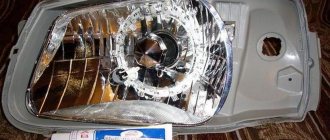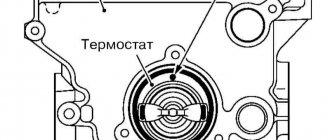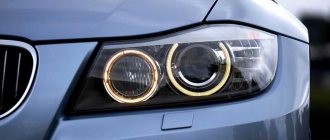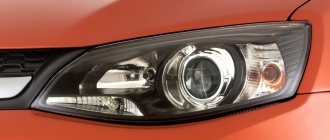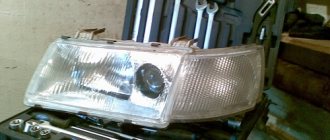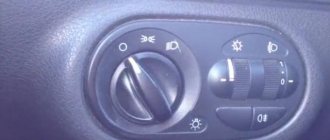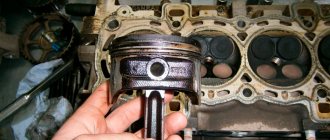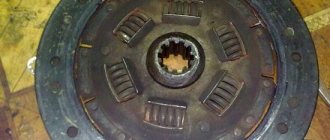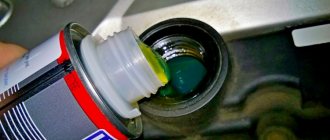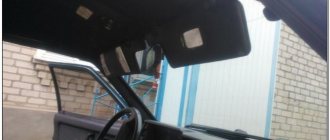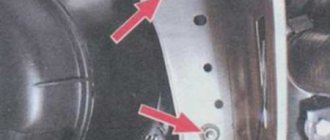Foggy headlights are a serious problem. Headlights can sweat even on new cars, and there are several reasons for this. Ignoring the problem can affect not only additional costs, but also ride comfort. So how to fix this problem? Find out from this article.
To properly troubleshoot the problem, you need to know the reasons for the appearance of water in the headlights. The reasons may be the following:
- Clogged hole in the ventilation system. There are two breathers inside the headlights through which air is ventilated. The hole may become clogged with debris from under the hood or during repairs, which is very rare.
- The light bulb was replaced incorrectly. Everything is simple here. The little paw stands crookedly in its hole.
- Cracks appeared in the glass. This can happen due to an accident or improper installation of the structure. Through the gap, moisture will always get inside the headlight.
- The sealant has dried out. Sealant tends to dry out over time. Depressurization can also occur due to an accident.
- Defective headlights. Cases are very rare. The glass may be crooked or have incorrect geometry.
- The hydraulic corrector is broken. Failure of the device results in leakage of liquid, which can get inside the headlight.
Foggy headlight
The fogging is so strong that it does not even allow you to determine the type of headlight.
The fogging is so strong that it does not even allow you to determine the type of headlight.
Generally speaking, absolutely all headlights and other car lights are a priori leaky. It cannot be otherwise: when heated, the temperature inside any headlight can easily change by 100 degrees! From minus 35, achievable in winter even in central Russia, to 60–70 degrees with the headlights on in the summer, in the sun. In addition, the rear part of the headlight is located in the engine compartment, where, as a rule, it is quite hot. At the same time, the air in the headlight naturally expands, and therefore cannot be avoided without exchange with the external environment.
Where there is contact, there is always the possibility of fogging. For example, if a cooling headlight sucks in moist air - say, at a car wash, then the transparent cap (previously it was a diffuser) according to the laws of physics has the right to become somewhat cloudy. Well, if the headlight has defects, then it has a much higher chance of fogging up. The once beloved Volga of one of the authors began to attract attention because the headlight glasses behaved differently - one was more transparent than the other. Soon everything became clear: during a visit to the service, one diffuser fell off by itself!
Is fogging dangerous? Without a doubt. It distorts the light distribution, which disturbs both the driver (the illumination of the road decreases) and other road users (it blinds them).
How to disassemble to eliminate condensation
Before separating the glass from the body, remove all lamps, removable correctors, breathers from the headlight, unscrew the plugs and disconnect the wires. It will not be possible to mechanically separate the sealant, so you will have to heat it. There are two popular ways to soften sealant:
- Heating the body in the oven. Suitable for compact models that will fit in the oven. The oven heats up to 150 degrees and turns off. The headlight is placed inside for 5 minutes. Then (using gloves) the case is removed and the glass is separated.
Not many headlights fit into such ovens
In both cases, haste is fraught with consequences - the experience of those in a hurry suggests: it is very easy to melt a headlight with a hair dryer! And then the need for repairs will disappear by itself, giving way to the purchase of new optics.
Use the lowest temperature setting and be very patient
After separating the headlight into its components, the old sealant should be removed. Reuse is not sustainable.
Fines for crossing the stop line and speeding will no longer bother you!
Cloudy headlight
The low beam of Largus's headlights is greatly distorted.
The low beam of Largus's headlights is greatly distorted.
At the same time, increased humidity inside the headlight housing destroys the coating of the reflectors. Well, there’s nothing to say about electrics: water and contacts will never make peace.
If the headlight is working properly, then, in general, there is nothing to be afraid of. The fogging will disappear as quickly as it appeared. The headlight, as we already mentioned, in cheap designs there is a tube directed downward, while more modern cars use special breathers with small filters for ventilation.
How to eliminate the causes of water appearing on lighting fixtures
- It is necessary to disconnect all power and control cables, and if there is a hydraulic corrector, disconnect the hoses.
- Remove the headlight housing and clean it of dust and dirt. Check the drainage holes - they often become clogged with dirt. Clean the drainage hoses.
- Check the condition of the O-rings in the connectors and lamp sockets. Replace damaged elements.
- Inspect the headlight housing and glass for visible cracks. Repair minor damage with headlight repair sealant. Try not to use compounds with volatile components: ammonia, acetone, etc. Vapors can settle on the reflector, forming a white coating.
- If during these measures the causes of fogging were not identified, it means that the tightness of the connection between the case and the glass has been broken. In this case, you will have to disassemble the headlight and remove the old seal, replacing it with a new one. Some designs allow you to add sealant along the edge of the glass without compromising the appearance.
Important! Use compounds intended for repairing headlights. Conventional construction acrylic sealant is not designed for such operating conditions.
headlight
Fog light Kia cee'd.
Two breathers are clearly visible. One for each section. Fog light Kia cee'd. Two breathers are clearly visible. One for each section.
What faults can cause fogging? Everything is simple here: most often the ventilation is simply clogged with dirt. Headlights with cracks also “walk on their own.” Some cases of fogging are associated with unprofessional disassembly/assembly of the headlight.
In such cases, there is only one piece of advice. Repair the headlight until all joints are sealed, so that only the standard “breathers” remain. If this does not work, the headlight must be replaced. No desiccant in the form of silica gel or pieces of diaper will help a faulty headlight.
And yet, how dangerous are drops of water caught in a headlight? We carried out a simple experiment: using a syringe we pumped 20 ml of water into the optics of the editorial Largus - this is quite a lot. We turned on the headlights, waited, then turned them off - well, yes, the hubcaps became cloudy. The light distribution became ugly. However, after a couple of days, after a relatively short run, the effect disappeared: the water safely evaporated into the atmosphere. Which, in fact, was what needed to be proven.
Of the useful tips regarding anti-fogging, we will mention, perhaps, only one: be careful when washing the engine compartment under pressure. A strong jet can rip off the “breathing caps” and cause trouble, after which you will have to seriously tinker with the headlight or replace it altogether.
High-quality ventilation is the key to success
There is nothing good about foggy headlights. Not only do the optics turn yellow and the reflectors rust. All this worsens lighting and increases the risk of accidents. Therefore, you need to take care of high-quality ventilation of optical instruments.
You must understand that the headlight housing is not made into a perfect vacuum. The air must get inside, but then go out through the drainage holes. For this reason, two breathers are installed in the block: the lower one for the entry of cold air and the upper one for the exit of hot air. Ventilation is achieved in this simple way.
Headlight ventilation on premium cars is especially well designed. For example, at one time the Audi Q 7 was equipped with turbines that operated on the principle of a home fan. They forced air inside, increasing air exchange. This automatically eliminated the formation of condensation. On budget car models, original designs are also sometimes found. On the same Kia, bags with silica gel not only absorb harmful moisture, but dry themselves.
Chevrolet Cobalt
The breathers of the Chevrolet Cobalt are sealed with blue non-woven material to prevent dust from entering.
The breathers of the Chevrolet Cobalt are sealed with blue non-woven material to prevent dust from entering.
Tell us in the comments if you have ever encountered fogging of lighting devices and how you dealt with this phenomenon.
Foggy headlight: treat or replace?
What problems could this cause?
This phenomenon should not go unnoticed, since ignoring it can lead to serious consequences, including:
1. Reduced security.
A foggy headlight cannot fully cope with its tasks, the lighting becomes less bright and does not allow the driver to sufficiently control the situation on the road.
2. Complete loss of performance properties.
Moisture that gets on the components of a given part, be it a lamp base, a fuse or a switch connector, is, at best, corrosion, leading to rapid wear of the product. In the worst case, the car owner will experience a short circuit, instantly depriving him of the opportunity to light his way. Both the first and second will lead the motorist to the need to repair the headlight or replace it.
Main causes of fogging
In fact, a headlight can fog up only in one case, when its seal is broken. But there may be several reasons why air gets inside this product and, in conditions of high humidity, the process of condensation begins from the inside.
Here are the two main ones:
— damage (cracks, crevices, and other defects that were not repaired in a timely manner resulting from an accident, unsuccessful parking, or sabotage by intruders);
- factory defects or ill-conceived design of the part (lack of sealing gaskets or their poor quality, prefabricated units of the product that do not fit tightly together, any other defects leading to the presence of areas through which air can get inside).
Ways to remove moisture
There are three options to resolve the problem, namely:
1. Buy a new headlight (it is better if preference is given to the original spare part, then there is much less chance of purchasing a defective or not fully thought out structural part).
2. Ask for help at a service station (the experts themselves will find the problem area and suggest the best solution to the problem, and they may be inclined either towards repairing the old headlight or towards purchasing a new component).
3. Get rid of the existing trouble on your own. This is perhaps the most budget-friendly option for combating headlight fogging (the first two require considerable financial costs). If the car owner decides to make an independent attempt to get rid of moisture inside the “light-giving” product, then he should adhere to the following algorithm of actions:
- find the “weak spot” (the simplest and most primitive method to do this is to lower the part into a container of water and carefully monitor where the air bubbles rise from);
— thoroughly dry the headlight (you can remove all the liquid by removing it from the car, if possible, or using a hairdryer to dry it if removing the part is very difficult);
- coat all problem areas with sealant, if necessary, replace rubber or plastic seals (gaskets), large cracks can be “preserved” using a special-purpose tinting film (in the worst case, you should try to find and replace the glass itself).
If the attempt is unsuccessful, then there is only one way - to the auto store for a new factory headlight. A little expensive, of course, but reliable!
What to do with foggy car optics? And should we pay attention to this?
Foggy headlight: treat or replace?Consequences of fogging
The appearance of water in the headlight unit is not as harmless as it might seem at first glance. Accumulating condensation can cause:
- rapid failure of lamps and diodes;
- premature wear of reflectors;
- oxidation of connectors and failure of the entire headlight;
- oxidation of wires and even short circuits.
To avoid all the problems listed above, it is important to take timely measures to eliminate fogging.
Eliminating fogging of the front optics on a Ford Focus 3 car
It is worth noting that headlights usually do not fog up opposite the lamps; most often, condensation appears on the glass below. On a Ford Focus 3, moisture accumulates most in the area of the turn signal; let’s look at how to eliminate the defect here.
We purchase corrugated door wiring and a standard nylon tie. We carefully make a hole in the lower ebb of the turn signal, use a soldering iron, since when drilling, the chips will get inside the body.
We fake holes on the sides of the ebb and install a screed in them.
We put the corrugation on top and fill it with padding polyester inside.
To ensure that the corrugation does not dangle, we tighten it with another tie to the body.
We got a new ventilation hole next to the turn signal, and now the glass on the headlight will not fog up.
